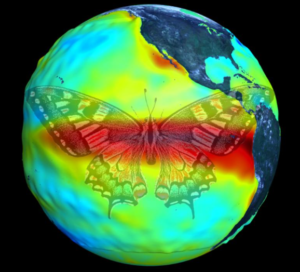Australia likely to experience up to 35% more El Niño under new projections
By Sophie Schmidt, CSIRO Communication Advisor
3 September 2020
A recent study has shed new light on the so-called ‘butterfly effect’ on the El-Niño Southern Oscillation (ENSO), finding that Australia is likely to receive stronger and more frequent El Niños over the coming decades.
The ‘butterfly effect’ is used by climate scientists to refer to an infinitesimal random perturbation to an identical initial condition (for example, in surface temperatures) causing drastically different El Niño trajectories.
El Niño is associated with low rainfall in western Pacific regions including eastern and southern Australia, and increased likelihood of drought, heatwaves and bushfires. It also causes flooding in the Equatorial Pacific.
The findings, published in Nature, discovered a ‘systematic relationship’ between past and future El Niño activity that could be used to improve long-term climate projection.
“El Niño stores a memory of its past behaviour, and organises its future accordingly,” Director of the Centre for Southern Hemisphere Oceans Research, and lead-author Dr Wenju Cai said.
“These findings mean that we have uncertainty in future El Niño projections – but we now have a gauge on it by examining its past behaviour,” Dr Cai said.
During El Niño years, the tropical Pacific Ocean warms, and the global mean temperature rises, as a result of equatorial Pacific surface winds taking heat out of the upper equatorial Pacific Ocean.
By running a model over 40 times, with identical starting conditions except for slightly different surface temperatures, researchers found that weak El Niño activity in an initial period may lead to higher future El Niño activity under greenhouse warming, because of the way ENSO organises itself over a multi-decadal to century lifespan.
The starting surface temperature conditions were modified in each experiment by an infinitesimally small difference – only one in a hundred trillionth (10-14) of a degree Celsius – akin to the ‘flap of a butterfly’s wings’.
Experiments in which the butterfly effect leads to lower El Niño activity in the first 50 years produced a greater increase in El Niño activity 150 years later, and vice versa. In these experiments, lower initial El Niño activity took less heat out of the equatorial Pacific, and a greater warming occurred, which caused higher El Niño activity in future decades.
“Given we have just come out of a hiatus period with low El Niño activity, our results suggest we can expect more frequent and strong El Niño activity in the upcoming decades,” Dr Cai said.
“We may experience up to 35% more El Niño activities under these new projections.”
Peter Hannam, writing for The Sydney Morning Herald, discusses the article here.
Read the full article on the Nature page.